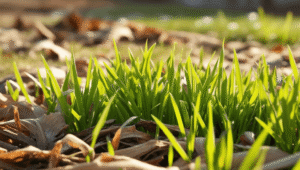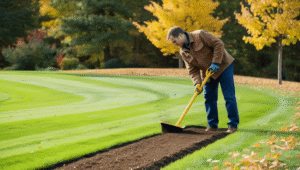How to Winterize Your Lawn for a Strong Spring Comeback (Chicagoland Edition)

When the Midwest cold rolls in, your lawn starts to go dormant—but that doesn’t mean your lawn care season is over. In fact, what you do before winter hits can make all the difference in how lush, green, and healthy your grass is come spring.
For homeowners in the Chicagoland area, winterizing your lawn is essential. With freezing temperatures, lake-effect snow, and periods of freeze-thaw, your turf needs a little extra TLC. Here’s how to prep your lawn for winter—and set the stage for a vibrant spring comeback.

1. Keep Mowing—But Lower the Blade at the End
Many people stop mowing too early in the fall, but grass continues to grow until the first hard frost. Continue mowing as needed through October and even into early November. For cool-season grasses common in northern Illinois (like Kentucky bluegrass, perennial ryegrass, and fine fescue), you want to keep the height around 2.5 to 3 inches for most of the fall.
Just before winter truly sets in, plan your final mow by lowering your blade slightly—to around 2 inches. This shorter height prevents the grass from becoming matted under snow, which reduces the chance of snow mold, a fungal disease that can wreak havoc in the spring.
Avoid cutting too short, though—scalping your lawn can stress it before the freeze and expose roots to harsh conditions.
2. Rake Up Leaves (Even if It’s Cold)
It might be tempting to let fallen leaves sit until spring, but that layer can block sunlight, trap moisture, and suffocate your grass. It also becomes a breeding ground for fungi and pests.
Make raking a regular habit in late fall. If you can’t keep up with the volume, consider mulching your leaves using a mulching mower. This breaks them down into smaller pieces that decompose naturally, adding nutrients back into the soil. Just make sure no more than 1/3 of your grass surface is covered with mulched leaves.
Pro tip: Avoid raking when the leaves or lawn are wet—it can tear up turf and compact the soil.
3. Aerate Your Lawn in Fall
If your soil feels hard, or your lawn sees heavy foot traffic, it may be compacted. That means roots struggle to grow, water has trouble penetrating, and oxygen levels are low.
Core aeration solves this by pulling small plugs of soil from the ground, allowing your lawn to “breathe.” Fall is an ideal time in Chicagoland to aerate because the soil is still soft and the grass is actively growing roots.
Aerate before you fertilize or overseed to allow nutrients and seeds to reach deeper into the soil. Renting a core aerator from a local hardware store or hiring a lawn care service can make a big difference in long-term lawn health.
4. Apply a Fall Fertilizer (The Most Important Feed of the Year)
Late fall is the best time to apply what many experts consider the most critical feeding of the year. A winterizer fertilizer helps strengthen roots, improve disease resistance, and set up a quicker green-up come spring.
Look for a product with a higher nitrogen and potassium content. Nitrogen promotes root growth and recovery from summer stress, while potassium helps the lawn build resistance to cold and disease. Apply in late October through mid-November when the grass has stopped growing but is still green.
Always follow label instructions and water the fertilizer in after application unless rain is expected.
5. Overseed Bare or Thin Spots (If Needed)
Got patchy spots or thinning turf? Fall is also a great time to overseed, especially in the Chicagoland area where cool-season grasses thrive in fall weather.
The best time to overseed is typically early to mid-September, but even into early October can work if the weather stays mild. Combine overseeding with aeration for optimal seed-to-soil contact.
After seeding, lightly rake the area and keep it consistently moist until germination occurs. That might mean watering lightly once or twice a day until the seeds sprout.
Choose a high-quality seed mix that matches your existing turf type and consider using a starter fertilizer to give new grass a healthy head start.

6. Keep Watering Until the Ground Freezes
It’s easy to forget about watering once the temperatures start to drop, but your grass needs hydration even in the fall. Roots continue to grow and absorb nutrients until the ground freezes, which usually happens in late November or early December in Chicagoland.
If rainfall is scarce, water your lawn deeply once or twice a week to ensure the soil stays moist. Dry grass going into winter is more susceptible to damage from frost and disease.
Use a rain gauge to track how much water your lawn is getting. Aim for about 1 inch of water per week, whether from rainfall or irrigation.
7. Clear Off Lawn Furniture and Toys
Lawn furniture, hoses, garden decor, and kids’ toys should all be put away before the snow flies. Leaving them out can create dead patches and uneven turf come spring.
Heavy objects press down on the grass and prevent sunlight and airflow, which invites disease and mold. Plus, they can freeze to the lawn and be hard to remove once snow arrives.
8. Avoid Excess Foot Traffic on Frozen Grass
Walking on frozen or frosty grass can snap the blades, causing lasting damage that you’ll only notice in spring. Try to stay off your lawn as much as possible during hard freezes or when there’s snow cover.
If you have pets, consider creating a designated potty area with straw or mulch to minimize damage to your main turf area.
9. Prep Your Lawn Tools and Mower for Winter
Winterizing your lawn isn’t just about the grass—your tools need love too. Clean off mud, grass, and debris from mowers, trimmers, and spreaders.
Sharpen mower blades to ensure a clean cut in the spring and avoid tearing grass. If you have a gas-powered mower, either drain the fuel or add a fuel stabilizer to prevent engine damage.
Store tools in a dry, covered area to prevent rust and prolong their lifespan.
10. Plan Ahead for Spring Success
Now is also a great time to take notes on what worked and what didn’t this year. Was there a persistent weed problem?
Bare spots that kept coming back? Keep a lawn journal or photo log so you can adjust your spring strategy.
Also, consider ordering seed and fertilizer early. Spring demand can lead to shortages, especially in local garden centers.
Final Thoughts: A Little Effort Now, Big Results Later
Winterizing your lawn might seem like a lot of work when temperatures are dropping and holiday season distractions are setting in. But trust us—your future self will thank you. The steps you take now will lead to fewer issues, faster recovery, and greener grass when spring finally shows up.
In a climate like Chicagoland, winter can be long and harsh. But your lawn doesn’t have to suffer. With a bit of planning and consistent fall maintenance, you’ll be the one with the lushest lawn on the block when the snow melts away that you and your family can enjoy!

Looking for more seasonal tips tailored to the Midwest? Subscribe to our blog and follow along for monthly lawn care advice, reminders, and how-to guides that keep your yard looking its best—no matter the weather.